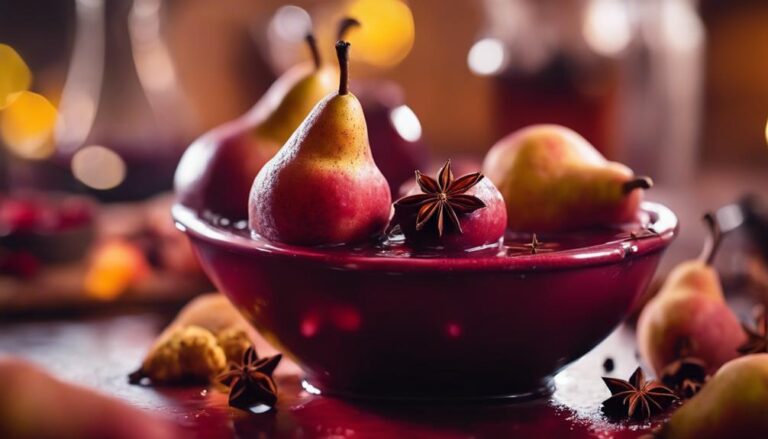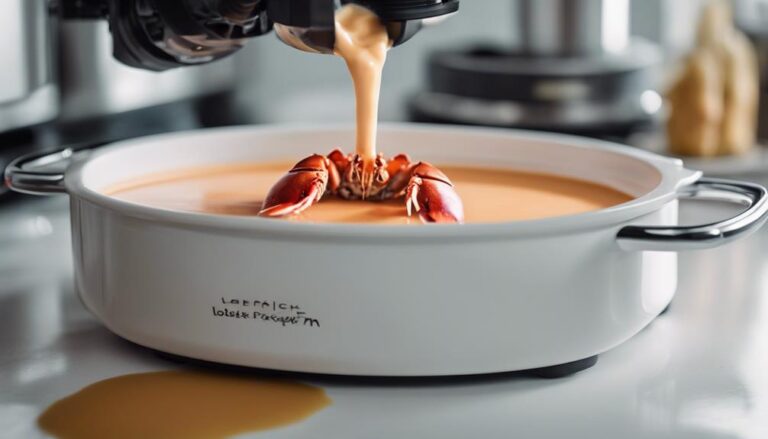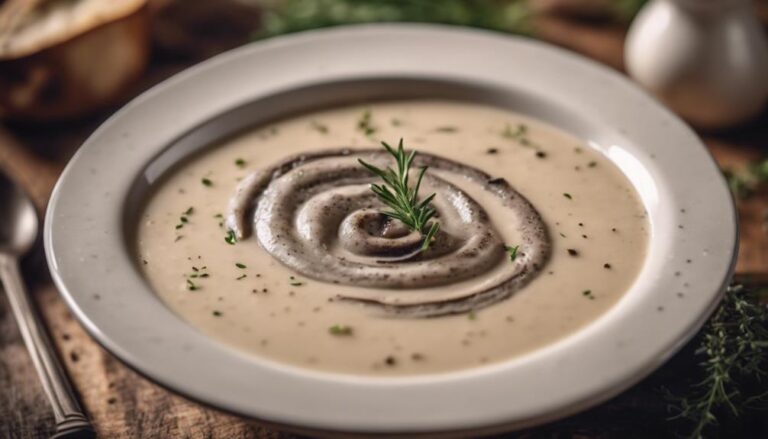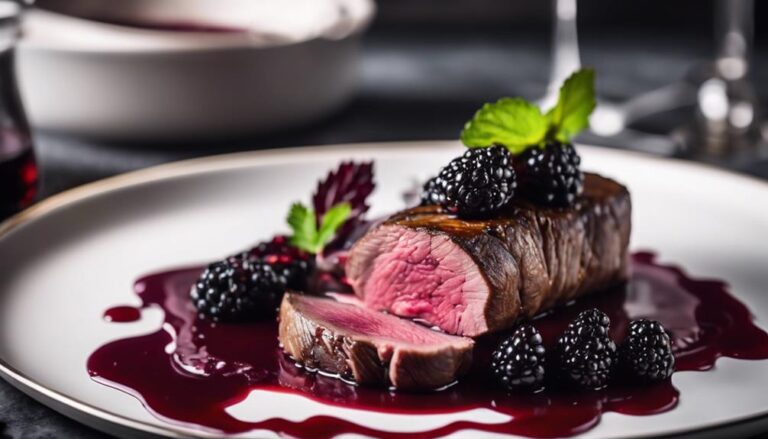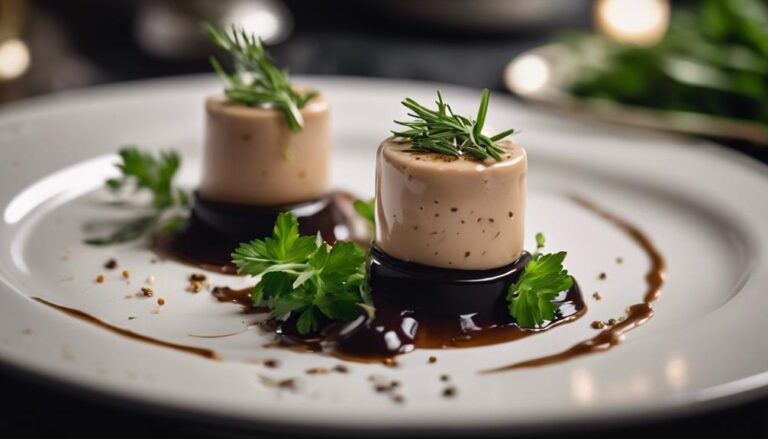Sous Vide Rabbit and Root Vegetable Stew
Picture a delightful blend of tender rabbit and the earthy goodness of root vegetables in a rich stew. With sous vide magic, the flavors meld perfectly, creating a medieval-meets-modern masterpiece. The juicy rabbit and hearty veggies harmonize, promising a culinary journey you won't forget. Indulge in a bowl of Sous Vide Rabbit and Root Vegetable Stew for a taste experience that's both comforting and luxurious. Ready to uncover how this dish marries tradition with innovation for a dish fit for royalty?
What You Will Learn Here
- Sous vide technique enhances rabbit tenderness and flavor.
- Root vegetables add depth and earthy sweetness to the stew.
- Culinary evolution combines medieval and modern cooking methods.
- Velvety texture achieved by blending and puréeing root vegetables.
- Rich broth infuses stew with essence of ingredients, creating a symphony of tastes.
Rabbit in Medieval Cuisine
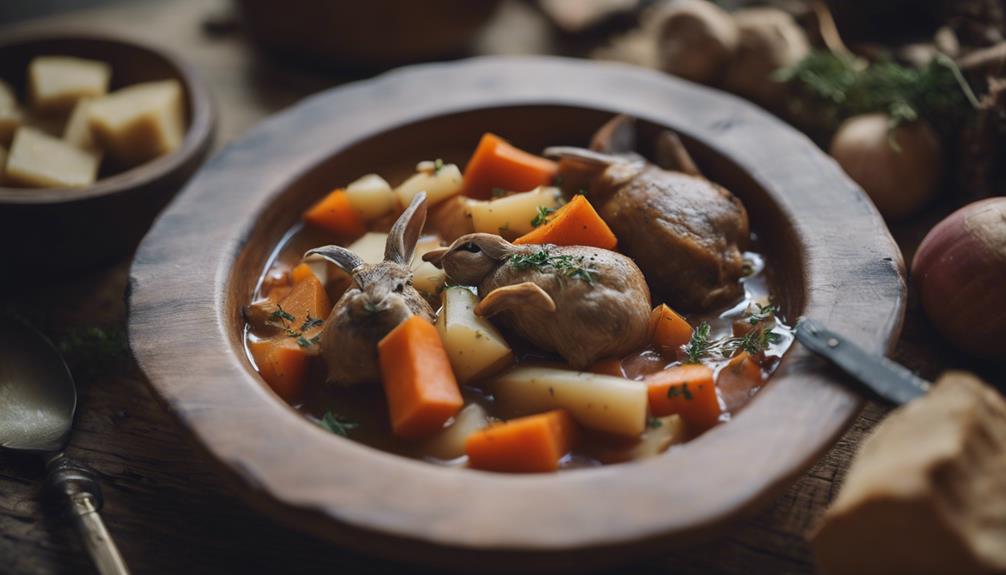
When you envision rabbits in medieval times, imagine this: fluffy creatures hopping into pots, not as pets, but as a noble dish fit for kings and queens.
Back in the day, rabbits were cooked up in all sorts of ways, showcasing the culinary creativity of the past.
Medieval Rabbit Preparation
During medieval times, rabbit was a common and versatile ingredient in European cuisine, often prepared in a variety of ways to suit different tastes and occasions. Back then, they didn't have fancy gadgets like sous vide machines, but they sure knew how to work their medieval cooking techniques to make rabbit dishes that would wow even the pickiest eaters.
Roasted, stewed, or even baked into pies, rabbits were a staple on the medieval dinner table. The innovation of sous vide cooking may not have been around, but that didn't stop our medieval friends from creating mouthwatering rabbit meals fit for kings and queens.
Culinary Traditions in History
Medieval cooks in Europe skillfully incorporated rabbit into their cuisine, showcasing the versatility of this flavorful meat in various dishes. Back in the day, rabbits weren't just cute fluffy creatures hopping around; they were also hopping into stews and pies! The culinary evolution of rabbit in medieval times saw these furry critters becoming a staple in many European kitchens.
These historical ingredients weren't just random additions to dishes; they were carefully chosen to add depth and richness to the flavors. Imagine the medieval chefs, with their pointy hats and serious faces, experimenting with rabbit recipes to create the perfect balance of taste. So next time you dig into a rabbit stew, remember, you're tasting a bit of delicious history!
Rabbit as Noble Dish
In exploring the culinary history of medieval Europe, rabbit emerged as a noble dish, celebrated for its versatility and rich flavor profile. Back in the day, rabbits weren't just cute woodland creatures; they were a medieval delicacy fit for kings and nobles alike. Imagine feasting on a succulent rabbit stew while knights jousted outside your castle walls! The modern adaptation of this medieval favorite can be seen in dishes like the Sous Vide Rabbit and Root Vegetable Stew, where tender rabbit meat is cooked to perfection alongside hearty root vegetables. Let's take a closer look at how this humble bunny hopped its way from the royal tables of yore to the sous vide bags of today:
| Medieval Dish | Modern Twist | Culinary Evolution |
|---|---|---|
| Rabbit Stew | Sous Vide Rabbit and Root Vegetable Stew | From hearth to precision cooking |
Roots and Herbs
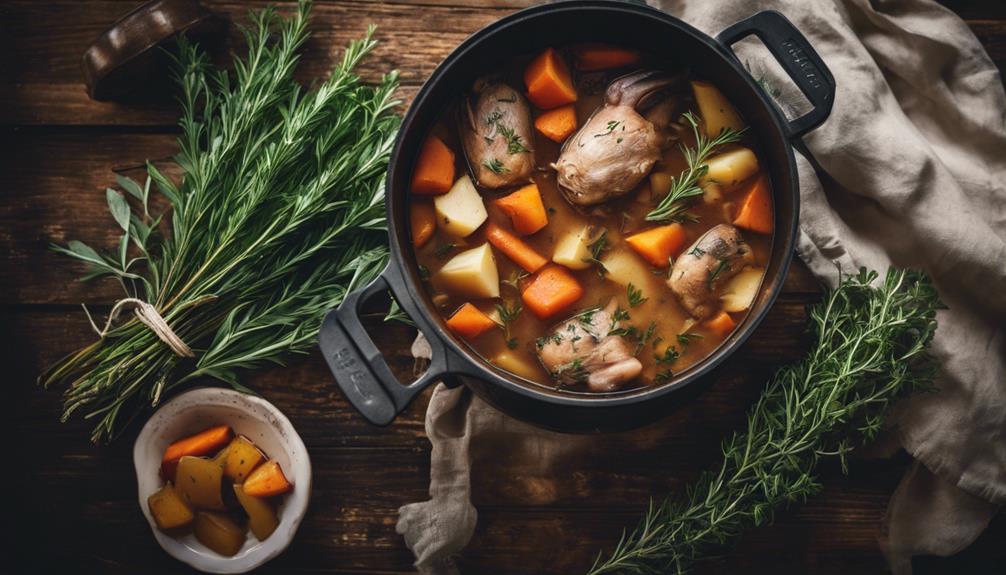
Root vegetables and herbs bring a depth of flavor and earthy aroma to the Sous Vide Rabbit stew. Here are some fun facts to spice up your culinary knowledge:
- Root Vegetable Pairings: Carrots, parsnips, and turnips make a fantastic trio when paired with rabbit in this stew. Their sweetness and texture complement the tender meat, creating a harmonious blend of flavors.
- Herb Preservation Techniques: To keep your herbs fresh longer, try wrapping them in a damp paper towel and storing them in a resealable bag in the fridge. You can also chop them up and freeze them in ice cube trays with a bit of water for easy future use.
- Root Vegetable Fun Fact: Did you know that beets aren't just for salads? They add a lovely earthy sweetness and vibrant color to stews like this one.
- Herb Tip: When using fresh herbs, remember that a little goes a long way. It's better to start with less and add more as needed to avoid overpowering your dish.
Rabbit Stew Variations
So, you want to add a twist to your rabbit stew game?
How about trying out a medieval rabbit stew recipe or maybe a herbed rabbit stew for a fragrant kick?
Don't forget to explore the savory rabbit stew variation for a burst of flavor that will have your taste buds dancing!
Medieval Rabbit Stew Recipe
For a medieval twist on rabbit stew, consider incorporating aromatic herbs like rosemary and thyme to enhance the flavors.
Here are some tips for creating a historical rabbit stew that will transport your taste buds back in time:
- Experiment with medieval cooking techniques like slow simmering over an open flame for an authentic touch.
- Research the historical recipe origins to understand the cultural influences behind each ingredient.
- Don't shy away from exotic spices and herbs that were prized during medieval times.
- Let your stew simmer for hours, allowing the flavors to meld together and create a rich, hearty dish fit for a king or queen.
Herbed Rabbit Stew
Enhance your rabbit stew with a blend of aromatic herbs for a flavorful twist on this classic dish. Here's how to take your herbed rabbit stew to the next level:
- Choose Your Herbed Spices: Experiment with a mix of rosemary, thyme, sage, and parsley for a fragrant and savory kick.
- Master Slow Cooking Techniques: Let the flavors meld together beautifully by simmering your stew on low heat for a few hours.
- Layer the Flavors: Add the herbed spices at different stages of cooking to build depth and complexity in each bite.
- Taste and Adjust: Don't be afraid to taste as you go and adjust the seasoning to suit your palate.
Savory Rabbit Stew Variation
To add a savory twist to your rabbit stew, consider incorporating a medley of earthy root vegetables for added depth and richness in flavor. Culinary techniques like slow cooking or braising can help meld the flavors together beautifully, giving you a hearty and satisfying dish.
Experiment with different herbs and spices to elevate the flavor profiles – think rosemary for a fragrant touch or smoked paprika for a subtle smokiness. Don't shy away from adding a splash of red wine or a dollop of Dijon mustard for an extra layer of complexity.
Stew Thickening Techniques
Alright, so you want to thicken that stew up a bit? Let's talk about some fun ways to do that.
You can go the classic route with a roux, get fancy with a cornstarch slurry, or sneak in some veggies with the vegetable purée technique.
Time to thicken things up and make that stew just right!
Roux for Thickening
For a classic method of thickening stews, consider starting with a roux – a simple mixture of equal parts flour and fat cooked together. Roux has its benefits; it not only thickens your stew but also adds a rich, savory flavor. Plus, it helps prevent lumps from forming, giving you that velvety texture you're craving.
If you're feeling adventurous or just ran out of flour, there are alternative methods to thicken your stew. You could try using cornstarch, which is a great gluten-free option and works like a charm. Or why not throw in some mashed potatoes for a hearty twist?
Whichever way you go, just remember to stir well and taste often – after all, the best stews are made with a little love and a lot of flavor!
Cornstarch Slurry Method
Consider using a cornstarch slurry to thicken your stew for a smooth and gluten-free option that works effectively. When looking for thickening alternatives in your rabbit cooking adventures, this method can be a game-changer.
To make a slurry, simply mix cornstarch with cold water before adding it to your simmering stew. This technique is great for those root veggies in your stew, as it won't overpower their natural flavors.
Slurry tips? Remember to whisk well to avoid clumps and add it gradually to reach your desired consistency. Plus, it's quick – no long waiting times for the stew to thicken.
Vegetable Purée Technique
To thicken your stew using the Vegetable Purée Technique, blend cooked root vegetables into a smooth consistency before incorporating it into the simmering stew. This method not only adds a velvety texture but also enhances the flavor profile of your dish.
When employing the blending technique, make sure that the purée is lump-free to achieve a seamless integration into the stew. Experiment with different root vegetable combinations like carrots, parsnips, and turnips to create unique flavor combinations that complement the rabbit meat.
The natural sweetness of root vegetables can amplify the savory notes of the stew, providing a well-rounded taste experience. So, get ready to blend your way to a thick and delicious stew that will have your taste buds doing a happy dance!
Final Thoughts
In conclusion, what truly shines in this sous vide rabbit and root vegetable stew is its depth of flavors and tender texture. By combining medieval cooking techniques with modern flavor profiles, this dish offers a unique culinary experience that marries the best of both worlds. The sous vide method guarantees that the rabbit is cooked to perfection, resulting in meat that practically melts in your mouth. The root vegetables, lovingly simmered in their own juices, add a hearty and earthy undertone to the stew.
As you take your first spoonful, you'll be greeted by a symphony of tastes that transport you through time and tradition. The rich broth, infused with the essence of the ingredients, tells a story of patience and precision in cooking. Each bite is a journey through centuries of culinary evolution, culminating in a bowl of comfort and warmth.
Frequently Asked Questions
Can I Use a Slow Cooker Instead of a Sous Vide Machine?
You can use a slow cooker instead of a sous vide machine. Slow cookers offer convenience and are great for long cooking times. While they differ in precision, both techniques can yield tender results. Follow slow cooking tips for best outcomes.
What Are Some Alternative Vegetables for the Stew?
You can switch up the veggies in the stew with roasted Brussels sprouts for a nutty flavor or sautéed kale for a hearty touch. These alternatives add variety and depth to your dish.
How Can I Make the Stew Spicier?
To make the stew spicier, try adding chili flakes or Tabasco for a kick. Experiment with jalapenos or curry powder for depth. Start by sprinkling some chili flakes and adjust to your taste. Enjoy the heat!
Can I Substitute Rabbit With Another Type of Meat?
If you want to switch up the meat, consider alternatives like chicken, venison, or pork in your stew. Experiment with various cooking methods to guarantee the meat is tender and flavorful in every bite.
Are There Any Dessert Recommendations to Pair With the Stew?
For a delightful dessert to pair with your stew, consider a rich chocolate mousse or a fruity berry tart. These sweet options will complement the savory flavors of the dish and provide a satisfying end to your meal.
Conclusion
So there you have it, folks! Sous vide rabbit and root vegetable stew may sound fancy, but it's actually a deliciously hearty dish that's perfect for cozy nights in or impressing your friends with your culinary skills.
With a rich history, versatile ingredients, and endless possibilities for customization, this stew is sure to become a staple in your cooking repertoire.
Give it a try and let your taste buds thank you later!






